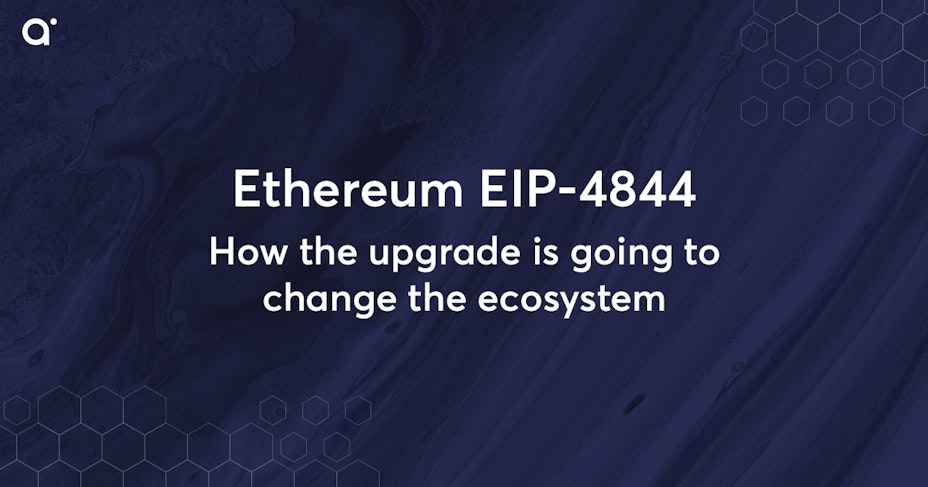Ethereum EIP-4844: How the upgrade is going to change Ethereum's ecosystem
- 5 minute read

The Ethereum community is watching Ethereum's EIP-4844 update with interest. What is it and how will the update affect Ethereum's ecosystem?

Brief summary:
- EIP-4844 Upgrade for scalability: The EIP-4844 upgrade aims to increase the scalability of the Ethereum network by introducing blob transactions.
- Blob transactions reduce costs: The upgrade introduces blob transactions, bundling data to reduce transaction costs, where Ethereum groups large amounts of transaction data into a single "container" or blob.
- Impact on Layer 2 projects: The introduction of blobs is having a positive impact on Layer 2 projects, including popular names such as Arbitrum, Polygon and Optimism. It lowers operational costs and makes these projects more attractive to users and developers.
- Benefits for Layer 2 networks with proprietary tokens: The EIP-4844 upgrade is considered especially beneficial for Layer 2 networks with proprietary tokens, as lower transaction costs and greater adoption may lead to an increase in token prices.
The transaction costs on the Ethereum -network have increased significantly since September due to the recent crypto rally, increasing the load on the network. Once again, Ethereum faced scaling problems, and the prediction is that these problems will only increase in the upcoming bull market.
According to data on Etherscan, even simple transactions such as token swaps can result in transaction costs of about 35 euros per transaction. So there is work to be done. Meanwhile, Ethereum developers are actively working to find a solution. The EIP-4844, which is prediction to be ready in the first quarter of 2024, is intended to provide significantly more scalability.
Inhoudsopgave
- What is the Ethereum EIP-4844 upgrade?
- Upgrade leads to increased use of Layer 2 networks
- In particular, Layer 2 networks with proprietary tokens benefit from the EIP-4844 upgrade
- Conclusion
What is the Ethereum EIP-4844 upgrade?
The EIP-4844 upgrade of Ethereum aims to make the network more efficient by increasing capacity and reducing transaction costs.
This is achieved by introducing a new transaction type called blob transaction. This involves bundling data, also known as a "blob." This data is not processed through the Ethereum Virtual Machine (EVM), but only a reference to the blob is made in the EVM. This saves on the amount of data to be processed in the transaction, resulting in lower costs.
Blob transactions in Ethereum are similar to shipping goods in logistics. Just as goods are bundled into containers to save costs, Ethereum groups large amounts of transaction data into a single "container" or blob. This leads to significantly lower gas costs for transactions on the Ethereum network.
The introduction of blobs has a positive impact on Layer 2 -projects, as they too benefit from a more efficient and cost-effective Ethereum mainchain. For Layer 2 projects, the upgrade means an immediate reduction in operational costs as they can consolidate their transaction data using blobs and forward it to the Ethereum mainchain.
Upgrade leads to increased use of Layer 2 networks
Layer 2 projects such as Arbitrum, Optimism and Polygon become more attractive to many people when transaction costs become lower. Thanks to blobs, transactions become more efficient, allowing more transactions to take place simultaneously. This improves overall scalability. As a result, transactions on Layer 2 projects become even cheaper and faster than on Ethereum's main network.
This opens the door for more innovation and encourages developer adoption, allowing the ecosystem to grow further. In short, the EIP-4844 upgrade is being received with enthusiasm by Layer 2 projects.
In particular, Layer 2 networks with proprietary tokens benefit from the EIP-4844 upgrade
The upgrade will especially benefit Layer 2 networks with their own tokens, as their platforms become more attractive to both users and developers. These networks have significantly lower transaction costs than Ethereum's main network. Increased use of these networks often goes hand in hand with increased demand for their tokens, potentially leading to an increase in token prices.
Some examples of Layer 2 projects in the Ethereum ecosystem include Arbitrum, Polygon and Optimism. Whether the upgrade will lead directly to an increase in the price of tokens, however, is difficult to predict.
Conclusion
In response to the significant increase in transaction costs on the Ethereum network since September, solutions to increase scalability are being actively sought. The upcoming EIP-4844 upgrade, scheduled for the first quarter of 2024, focuses on making the network more efficient by introducing blob transactions. This innovation aggregates data, resulting in lower transaction costs.
The upgrade not only has direct benefits for the Ethereum mainnet, but also positive implications for Layer 2 projects such as Arbitrum, Polygon and Optimism. Lower costs and more efficient transactions will make these networks more attractive to users and developers. Layer 2 networks with proprietary tokens are especially expected to benefit, as lower costs and greater adoption can contribute to an increase in token prices. Thus, the EIP-4844 upgrade is being received with enthusiasm by the Ethereum community and promises a positive boost for the entire ecosystem.


